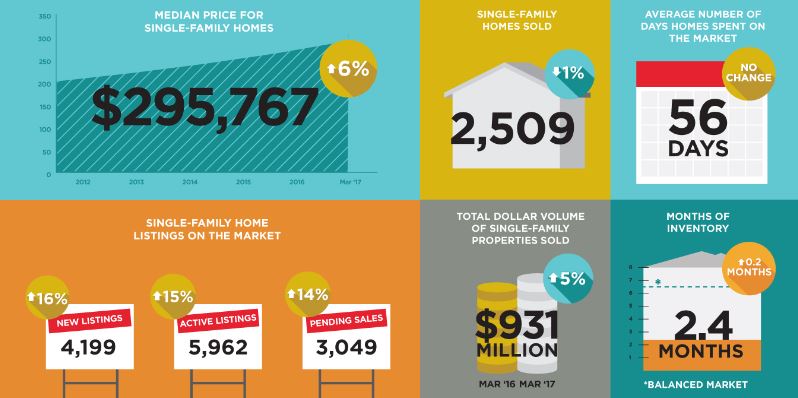AUSTIN, Texas – April 20, 2017 – Single-family home sales declined across the Austin-Round Rock Metropolitan Statistical Area (MSA) and increased in the city of Austin in March, according to the March 2017 Central Texas Housing Market Report released today by the Austin Board of REALTORS®. Analyzing a growing disparity in market conditions among housing price classes, the report underscored the need for policies that create additional housing capacity to meet the market demand and a broader range of housing types throughout the region.
Brandy Guthrie, 2017 President of the Austin Board of REALTORS® commented, “Growing disparities in housing market conditions at all levels of pricing represent an urgent and immediate need to fill the ‘missing middle’ in the region’s housing stock. The City of Austin’s CodeNEXT Zoning Comparison released earlier this week has given us a more tangible view of that need and confirmed the Austin Board of REALTORS® concerns about the draft land development code. Our newly adopted Strategic Housing Blueprint calls for the equitable disbursement of affordability throughout the city and we’ll need more substantive change than what’s been proposed to get there.”
In March 2017, single-family home sales in the Austin-Round Rock MSA declined 1.4 percent year-over-year to 2,509 home sales. During the same time frame, median price for single-family homes increased 5.6 percent to $295,767, and housing inventory increased 0.2 months to 2.4 months of inventory.
Within the city of Austin, single-family home sales increased 1.2 percent year-over-year to 780 home sales in March 2017. The median price for single-family homes jumped 12.6 percent from March 2016 to $371,606, and housing inventory increased 0.1 months to 1.8 months of inventory.
| City of Austin Single-Family Home Sales by Price Class: March 2017 | ||
| Price Class | Sales Volume | Change from March 2016 |
| $0 – $69,999 | 0 | 0.0% |
| $70,000 – $99,999 | 0 | -100.0% |
| $100,000 – $149,999 | 2 | -90.9% |
| $150,000 – $199,999 | 28 | -56.7% |
| $200,000 – $249,999 | 88 | -16.5% |
| $250,000 – $299,999 | 117 | -22.3% |
| $300,000 – $399,999 | 211 | 13.4% |
| $400,000 – $499,999 | 119 | 15.8% |
| $500,000 – $749,999 | 141 | 2.4% |
| $750,000 – $999,999 | 46 | 20.0% |
| $1,000,000 + | 28 | 13.0% |
An analysis of March 2017 housing market data by price class revealed disparities in sales activity, time spent on the market and inventory of single-family homes throughout the region. Price class breakdowns of single-family home sales revealed annual declines in the sales volume and availability of lower-priced homes and corresponding gains in the sales volume and inventory of higher-priced homes.
In the city of Austin, sales volume among single-family homes priced less than $300,000 fell sharply in March 2017, while the volume of homes sold for $300,000 and higher increased significantly during the same time frame (see chart).
The monthly housing inventory for single-family homes priced $250,000 or less in the city of Austin was less than half a month in March 2017, or essentially nonexistent. Single-family homes priced between $150,000 and $250,000 spent less than one month on the market in March 2017. During the same time frame, Austin single-family homes priced $500,000 and higher spent more than 60 days on the market and posted significantly higher inventory levels.
Dr. Jim Gaines, Chief Economist for The Real Estate Center at Texas A&M University, agreed: “As population grows and residents seek to live in closer proximity to key activities, demand is created for greater density. Without more housing, homebuyers and developers are forced to look outward; but there are often many ways that existing residential neighborhoods can be zoned to allow for greater infill. Central Texas, especially Austin, is rapidly approaching a critical mass of population growth when city leaders may be forced to create imaginative, higher-density options to accommodate popular demand.”
“Townhomes, duplexes, mid-rise condos and smaller single-family homes are all solutions that can increase density throughout Austin, but those solutions continue to be largely prevented in the proposed zoning changes,” said Guthrie. “As local market experts, Central Texas REALTORS® recognize the necessary balance of promoting the greater community benefit of affordability and preserving the character and quality of our communities, but we also believe that this balance can be achieved in a way that enhances, not deters from our neighborhoods.”
Guthrie concluded, “The Austin Board of REALTORS® looks forward to working with the community at large and policymakers to continue to refine the Land Development Code in a way that allows for a diverse set of housing types throughout our communities and gives access to affordability all over Austin.”

